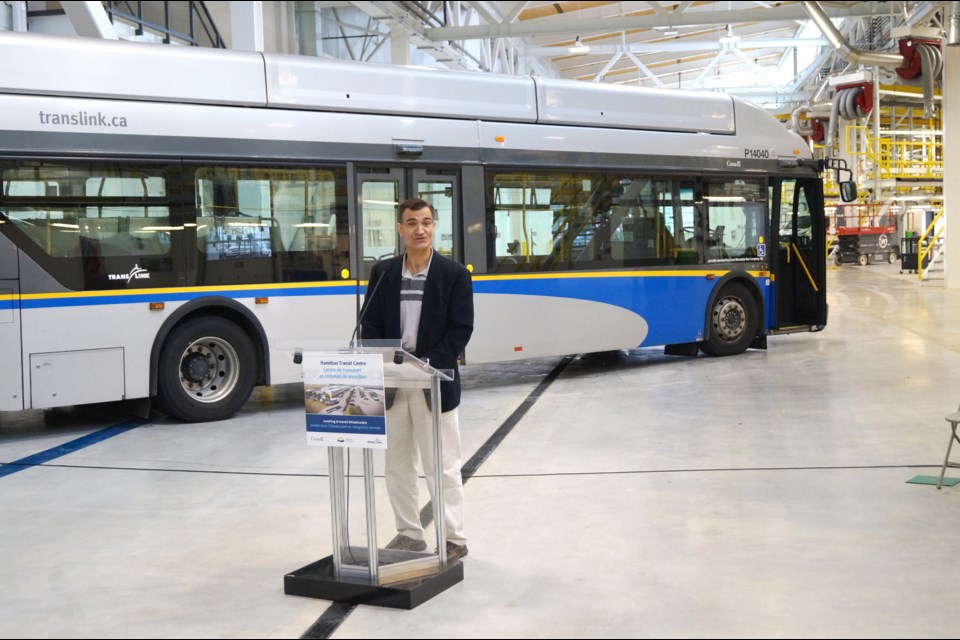Another piece of the Lower Mainland’s transit puzzle was put in place Monday in Richmond, as buses started moving in and out of the brand new, $136 million Hamilton Transit Centre near Queensborough.
On Friday, Steveston-Richmond East MP Joe Peschisolido was on hand to ceremoniously open the new bus depot, which should bring hundreds of jobs to Richmond.
The centre was mostly paid for by federal gas tax revenue — $85 million to be exact, with TransLink providing the remaining $51 million. It will see up to 300 regular buses, 80 community shuttles and 150 compressed natural gas buses serviced and/or parked at one time.
Peschisolido said the centre is important for the region to grow while supporting greenhouse gas emission reduction targets, by way of improved public transit.
Acting mayor Coun. Harold Steves was on hand to open the centre, hailing it and TransLink.
“To support this goal, our visionary and highly-successful City Centre Area Plan was developed around the concept of transit-oriented development. This system is aimed at taking full advantage of the Canada Line . . . to take more people out of cars,” said Steves.
City council approved the centre in exchange for “considerable” community benefits, said Steves, including $1.77 million for the nearby Cranberry daycare facility.
The bus depot has resulted in some concerns from Steveston residents, particularly on Fourth Avenue, who will now see more bus traffic, as routes for the 410 and 430 buses have been amended to station the vehicles in Hamilton.
“While more buses will be travelling on Fourth Avenue, local residents can expect many of those buses to be the CNG (compressed natural gas) variety, which are quieter and have fewer emissions. We encourage residents to keep us apprised of the service changes through our many feedback options,” stated TransLink spokesperson Cheryl Ziola, via email to the Richmond News.
TransLink CEO Kevin Desmond said minimizing the impact on residential streets is “very important for us, but we need to strike that balance.”
Notably, any bus that heads west on Westminster Highway, from the centre, must be in service.
Desmond said the centre will provide extra capacity for the bus system, allowing TransLink to leverage more federal and provincial money for the transit system.
This year’s federal budget earmarked $370 million for “Phase One” Lower Mainland transit projects over the next three years (largely for planning a Broadway subway line and a light-rail line in Surrey).
Desmond said the Canada Line will get new trains at some point after late 2018.
“We’re moving as quickly as we can toward the procurement of those rail cars,” he said.
Plans also include increased bus service and road and cycling lane improvements.
Phase Two, if funded, is expected to see the construction of the new rapid transit lines in Vancouver and Surrey. Included in that phase, for Richmond, will be a rapid bus line to Metrotown and expansion of Canada Line platforms to increase capacity.
Additionally, a bus exchange for Steveston is also planned.
TransLink is presently reviewing its area plan for Richmond and is expected to present a draft to the public this fall (one year later than expected).
Peter Fassbender, B.C.’s Minister Responsible for TransLink, stated Friday that his government is committed to creating a “sustainable transportation system for the region.”
City spokesperson Ted Townsend told the Richmond News procuring funding for the $25 million Capstan Way Canada Line station through development fees is about 40 per cent complete.
The station’s timeline is dependent on development permits being issued and Townsend said there appears to be no sign of slowing down after the city saw a record level of construction in 2015.



